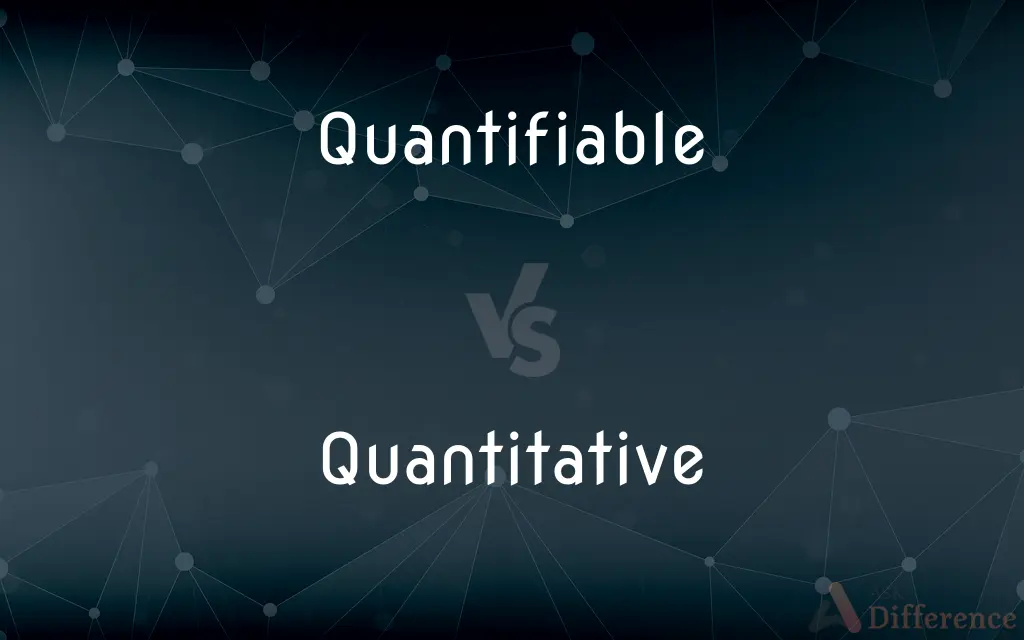Quantifiable vs. Quantitative — What's the Difference?
By Tayyaba Rehman & Maham Liaqat — Updated on April 20, 2024
Quantifiable refers to anything that can be measured or counted, while quantitative specifically describes data or research that expresses information in numerical form.

Difference Between Quantifiable and Quantitative
Table of Contents
ADVERTISEMENT
Key Differences
Quantifiable describes characteristics or attributes that can be measured or counted, even if they are not currently expressed in numbers. For instance, customer satisfaction can be quantified through surveys and then expressed as data. On the other hand, quantitative specifically pertains to data or analysis that is already in numerical form, such as statistics derived from measurements.
In research contexts, quantifiable elements are those aspects of a study that can potentially be measured, such as the number of participants or the frequency of an event. Whereas, quantitative research is characterized by the use of numerical data to uncover patterns and draw conclusions, often employing statistical methods to analyze the data.
Quantifiable metrics are essential in fields such as business, where performance metrics can be quantified to assess productivity, sales, and other operational factors. Quantitative data, however, is crucial for making data-driven decisions, as it provides the numerical evidence needed to justify strategies and policies.
While all quantitative data is inherently quantifiable, not all quantifiable data is initially quantitative. For example, employee engagement can be quantified through various metrics, and those metrics can subsequently be analyzed using quantitative methods to provide a deeper understanding of trends and impacts.
The ability to quantify something means it can be converted into a form suitable for quantitative analysis. This conversion is vital in sectors like health care, where patient symptoms (quantifiable) are often translated into quantitative scales to evaluate treatment effectiveness.
ADVERTISEMENT
Comparison Chart
Definition
Capable of being measured or counted
Expressed or expressible as a quantity or amount in numbers
Application
General assessment or potential for measurement
Specific method involving numbers for analysis
Example Usage
Determining if a feature can be measured
Analyzing data using statistical tools
Field of Use
Business, science, general research
Statistical analysis, scientific research, data science
Data Nature
Not necessarily initially numerical
Always numerical
Compare with Definitions
Quantifiable
Possible to count or measure.
Changes in air quality are quantifiable through pollutant levels.
Quantitative
Data expressed numerically.
The study’s quantitative data showed trends in population growth.
Quantifiable
Measurable in terms of quantity.
The effectiveness of the marketing campaign is quantifiable by customer engagement metrics.
Quantitative
Involving numbers or quantities.
Quantitative analysis revealed a 20% increase in sales.
Quantifiable
Translatable into numerical data.
The company's growth is quantifiable by its yearly revenue increase.
Quantitative
Measured by the quantity of something.
The quantitative results of the survey were used to improve the product.
Quantifiable
Capable of being measured.
The quantifiable outcomes of the project included the number of users reached.
Quantitative
Pertaining to quantity.
The quantitative restrictions limit the amount of imports.
Quantifiable
Assessable or evaluable by quantity.
The environmental impact of the new policy is quantifiable by studying the emission statistics.
Quantitative
Utilizing statistical methods.
The researcher used quantitative techniques to evaluate the data.
Quantifiable
To determine or express the quantity of.
Quantitative
Expressed or expressible as a quantity.
Quantifiable
(Logic) To limit the variables of (a proposition) by prefixing an operator such as all or some.
Quantitative
Of, relating to, or susceptible of measurement.
Quantifiable
Capable of being quantified.
Quantitative
Of or relating to number or quantity.
Quantifiable
Something that can be quantified; a measurable.
Quantitative
Of or relating to a metrical system based on the duration of syllables rather than on stress. Used especially of classical Greek and Latin verse.
Quantifiable
Capable of being quantified
Quantitative
Of a measurement based on some quantity or number rather than on some quality
Quantitative
(chemistry) Of a form of analysis that determines the amount of some element or compound in a sample
Quantitative
Relating to quantity.
Quantitative
Expressible as a quantity or relating to or susceptible of measurement;
Export wheat without quantitative limitations
Quantitative analysis determines the amounts and proportions of the chemical constituents of a substance or mixture
Quantitative
Relating to the measurement of quantity;
Quantitative studies
Quantitative
(of verse) having a metric system based on relative duration of syllables;
In typical Greek and Latin verse of the classical period the rhymic system is based on some arrangement of long and short elements
Common Curiosities
How does quantifiable data differ from qualitative data?
Quantifiable data can be measured and expressed numerically, while qualitative data is descriptive and characterizes attributes that are not inherently numerical.
What is quantitative data?
Quantitative data refers to information that is specifically numerical and is often used in statistical analysis to quantify variables and compare data points.
Can qualitative data be made quantifiable?
Yes, qualitative data can often be made quantifiable through methods like coding responses or using scales (e.g., Likert scales) to convert opinions or observations into numbers.
Can all aspects of a business be quantified?
While many business operations and outcomes can be quantified, such as sales, costs, and employee productivity, some aspects like brand reputation and employee morale are more challenging to measure directly and may require indirect quantification methods.
What does it mean if something is quantifiable?
If something is quantifiable, it means it can be measured or counted, either directly or by converting into a measurable format.
Why is quantitative analysis important in research?
Quantitative analysis is important because it allows researchers to precisely measure and analyze variables, facilitating objective comparisons and statistical validation of hypotheses.
What are examples of quantifiable data in healthcare?
In healthcare, quantifiable data can include patient counts, medication dosages, surgery durations, and recovery rates, which are measurable aspects crucial for clinical studies and healthcare management.
How are quantifiable and quantitative data utilized in environmental studies?
In environmental studies, quantifiable data such as species count, pollution levels, and land use changes are essential for monitoring ecosystems, which can be analyzed using quantitative methods to assess impacts, trends, and to formulate environmental policies.
How does technology impact the quantification of data?
Technology significantly enhances the ability to quantify data through tools like sensors, online analytics, and software that automate data collection and conversion, providing more accurate and real-time data for quantitative analysis.
How are quantifiable and quantitative data used in business?
In business, quantifiable data (like customer ratings) can be converted into quantitative data (numerical scores) to analyze trends, performance, and outcomes statistically.
What are the limitations of quantitative methods?
While quantitative methods are powerful for statistical analysis and generalization, they may not capture the depth of complex, subjective experiences like qualitative methods do.
What role do quantitative methods play in improving educational outcomes?
Quantitative methods play a crucial role in education by allowing for the measurement of student performance, assessment effectiveness, and program evaluations, which can lead to data-driven decisions to enhance educational strategies and outcomes.
Share Your Discovery

Previous Comparison
Change vs. Development
Next Comparison
Presto vs. VivaceAuthor Spotlight
Written by
Tayyaba RehmanTayyaba Rehman is a distinguished writer, currently serving as a primary contributor to askdifference.com. As a researcher in semantics and etymology, Tayyaba's passion for the complexity of languages and their distinctions has found a perfect home on the platform. Tayyaba delves into the intricacies of language, distinguishing between commonly confused words and phrases, thereby providing clarity for readers worldwide.
Co-written by
Maham Liaqat












































